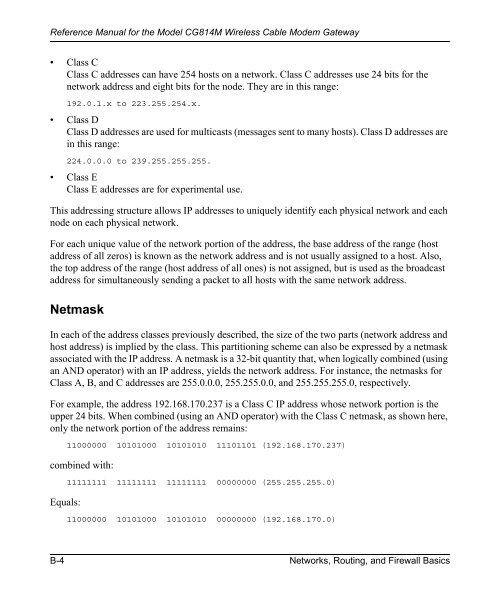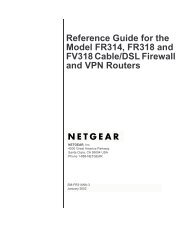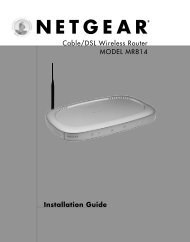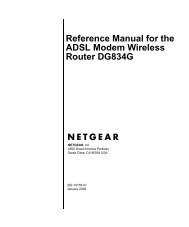Reference Manual for the Model CG814M Wireless Cable ... - netgear
Reference Manual for the Model CG814M Wireless Cable ... - netgear
Reference Manual for the Model CG814M Wireless Cable ... - netgear
Create successful ePaper yourself
Turn your PDF publications into a flip-book with our unique Google optimized e-Paper software.
<strong>Reference</strong> <strong>Manual</strong> <strong>for</strong> <strong>the</strong> <strong>Model</strong> <strong>CG814M</strong> <strong>Wireless</strong> <strong>Cable</strong> Modem Gateway<br />
• Class C<br />
Class C addresses can have 254 hosts on a network. Class C addresses use 24 bits <strong>for</strong> <strong>the</strong><br />
network address and eight bits <strong>for</strong> <strong>the</strong> node. They are in this range:<br />
192.0.1.x to 223.255.254.x.<br />
• Class D<br />
Class D addresses are used <strong>for</strong> multicasts (messages sent to many hosts). Class D addresses are<br />
in this range:<br />
224.0.0.0 to 239.255.255.255.<br />
• Class E<br />
Class E addresses are <strong>for</strong> experimental use.<br />
This addressing structure allows IP addresses to uniquely identify each physical network and each<br />
node on each physical network.<br />
For each unique value of <strong>the</strong> network portion of <strong>the</strong> address, <strong>the</strong> base address of <strong>the</strong> range (host<br />
address of all zeros) is known as <strong>the</strong> network address and is not usually assigned to a host. Also,<br />
<strong>the</strong> top address of <strong>the</strong> range (host address of all ones) is not assigned, but is used as <strong>the</strong> broadcast<br />
address <strong>for</strong> simultaneously sending a packet to all hosts with <strong>the</strong> same network address.<br />
Netmask<br />
In each of <strong>the</strong> address classes previously described, <strong>the</strong> size of <strong>the</strong> two parts (network address and<br />
host address) is implied by <strong>the</strong> class. This partitioning scheme can also be expressed by a netmask<br />
associated with <strong>the</strong> IP address. A netmask is a 32-bit quantity that, when logically combined (using<br />
an AND operator) with an IP address, yields <strong>the</strong> network address. For instance, <strong>the</strong> netmasks <strong>for</strong><br />
Class A, B, and C addresses are 255.0.0.0, 255.255.0.0, and 255.255.255.0, respectively.<br />
For example, <strong>the</strong> address 192.168.170.237 is a Class C IP address whose network portion is <strong>the</strong><br />
upper 24 bits. When combined (using an AND operator) with <strong>the</strong> Class C netmask, as shown here,<br />
only <strong>the</strong> network portion of <strong>the</strong> address remains:<br />
11000000 10101000 10101010 11101101 (192.168.170.237)<br />
combined with:<br />
Equals:<br />
11111111 11111111 11111111 00000000 (255.255.255.0)<br />
11000000 10101000 10101010 00000000 (192.168.170.0)<br />
B-4 Networks, Routing, and Firewall Basics
















